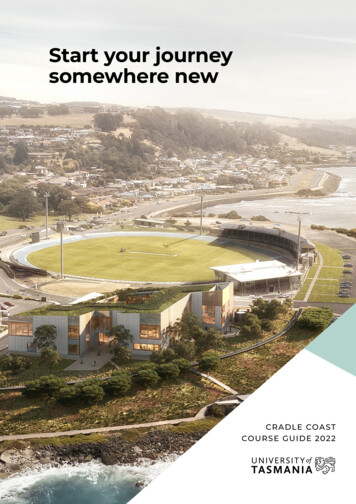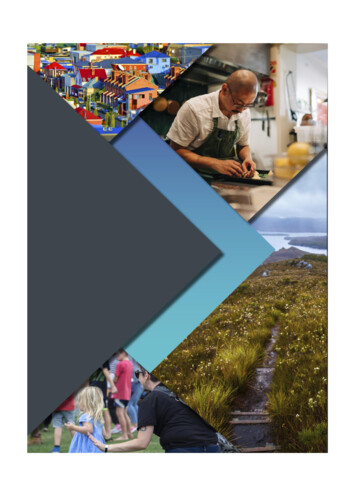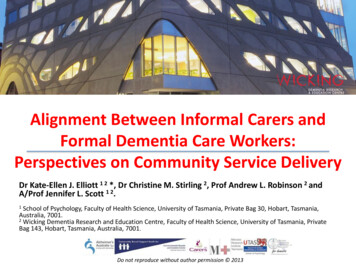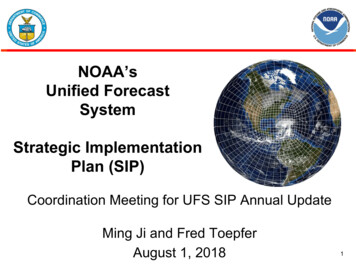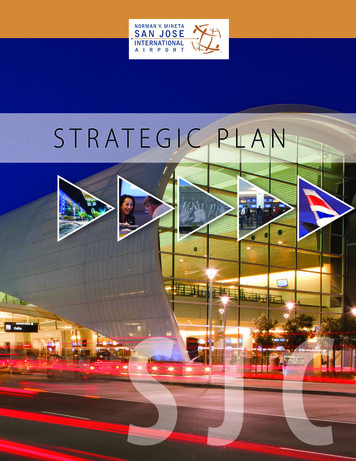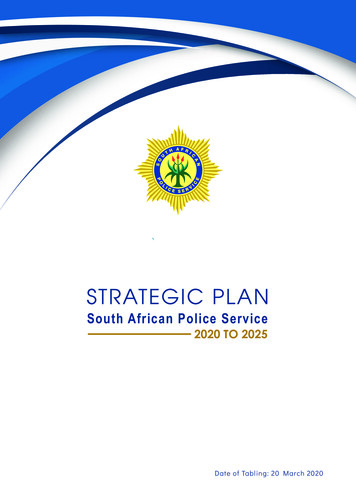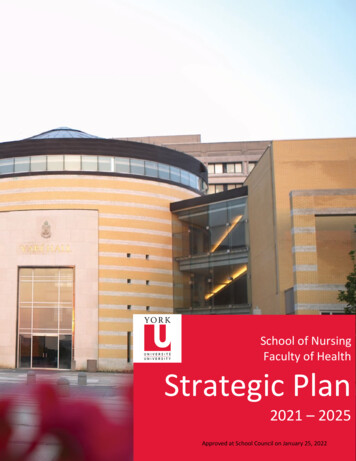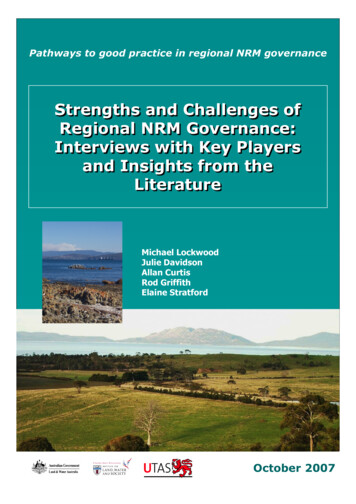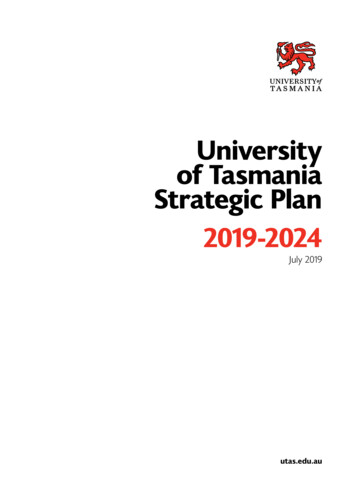
Transcription
Universityof TasmaniaStrategic Plan2019-2024July 2019utas.edu.au
Contents3Honouring our first people andtheir ongoing contribution4A map for navigatingthe next five years6Our mission8The strengths we have10The challenges we haveto deliver our mission13Our strategies17Conclusion18College of Arts, Law and Education20College of Sciences and Engineering22College of Health and Medicine24College of Business and Economics26University College28Research Division30Academic Division32Global and Marketing34Chief Operating Officer Division36Measuring the progressof our journey43Continuing the conversation2 University of TasmaniaScience studentslearning in the fieldat the base of kunanyi/Mount Wellington.
ACKNOWLEDGMENT OF COUNTRYHonouring our firstpeople and theirongoing contributionWe acknowledge the palawa and Gadigal, the traditionalowners of the land on which we live and work, and werecognise their enduring culture. We also recognisethat decisions about the future shape of Aboriginaleducation and research here are, first and foremost,ones to be made by Aboriginal leaders within theUniversity, in discussion with other senior leaders.We seek the wisdom of Aboriginal leaders with theirdeep knowledge of country as we explore how to be auniversity that has place as the centre of its thinking.University of Tasmania 3
STRATEGIC PLANA map for navigatingthe next five yearsLast year we conducted a seriesof cascading conversations thatstarted with a set of questionsabout the nature of our missionand how we wanted to characterisethe University of Tasmania.That thinking came together inour Strategic Direction documentin November. It emphasisedthemes of being place-based andglobally connected, right-sized andresponsive, regionally networkedto provide quality and access,and being people-centred. Werecognised that in being that kindof university, our setting bringsgreat strengths and challenges.4 University of TasmaniaOver the last six months, the collegesand divisions have worked togetherto develop a strategic plan to deliverour mission in a way that enables usto capitalise on our strengths andmeet our challenges. This documentsummarises that work. The overallpicture here is supported in eachcollege and division by more detailedoperational, financial and peopleplans. Together, these documentsenable us to work on a five-yearhorizon so that our choices willbe guided by a long-term view.Our mission to make a differencefor lutruwita/Tasmania, and fromTasmania to the world, is a long-termone that requires a long-term plan.The contribution of our people andtheir unique skills and perspectives inachieving our mission is paramount.It is also a mission that requiresus to work in deep and sustainedpartnerships, both internally and withthe many other organisations andpeople across the State and aroundthe world who are also committedto creating that better future. It isnot something we can achieve alone,but only together with others. Along-term plan will help us create andstrengthen these critical partnerships.
STRATEGIC PLANWe start with an overview of ourmission, strengths and challengesand the overall strategy. Becausestrategy matters only if it is relevantto the day-to-day lives of everyonewho is part of it, the document thensets out what the strategy means,more specifically, for each collegeand division. Our task is to take thatpicture and break it down, to figureout what it means in our particularpart of the University and the workwe do with our colleagues. For, in theend, it will be the collegial work thatwe do to realise this vision that willmake all the difference.Finally, the document will close withan overview of how we will trackour progress and measure successin bringing our strategies to life.efforts across a large and complexorganisation, their real importanceis to empower people to act on theprinciples embodied within them.This will help ensure we stay focusedon our mission, allowing us to adjustearly when our approach doesnot have the desired effect and tosustain the conversations acrossthe University on the questions weare answering and whether we areanswering them in the right way.That empowerment is an opportunityfor everyone in every role to workwith those inside and beyond theUniversity to see Tasmania realiseits full potential, to become oneof the very special places on theplanet, a place that people canlook to as a model for how tocreate a truly sustainable, equitableand prosperous society whilepreserving the distinctive qualitiesthat make it such a special place.While strategic documents such asthis play a necessary role in helpingus make consistent choices aboutpriorities and coordinating ourScience studentsinvestigate uniquegeological formationsat the TessellatedPavement,Eaglehawk.University of Tasmania 5
STRATEGIC PLANOur missionA PLACE WHERE WE DO THINGS FORTASMANIA AND FROM TASMANIAPlace shapes our mission and howwe deliver it. It starts with Tasmania,because that is our home, but it doesnot end there. Being the Universityof Tasmania makes us a universityfor Tasmania but also one wherewe do things from Tasmania.We are a university that was foundedto serve an entire State and itspeople, and we remain the onlyuniversity specifically for thissociety. Societies such as ours arecharacterised by the value theyplace on the ennobling potential ofeducation, discovery and creativity.Equally, sustainable social, economicand cultural progress requiresever-higher levels of capability andconstant investigation to solve thecomplex problems and questions thatwe face. There are always these twoparts to our mission, and we needto avoid false, forced choices thatwe need to do one over the other.Our task is to find ways to do both.The University'sInstitute for Marineand Antarctic Studieson the HobartWaterfront.6 University of TasmaniaFrom Tasmania to the worldIf part of our place-based missionis to be the university for Tasmania,we are strategically placed inthe world to do vital thingsfrom Tasmania for the world.Our unique location, our islandcharacter and our complex historybring both the obligation and theopportunity to make a distinctiveglobal contribution. Our proximity tothe Southern Ocean and Antarcticahas produced research strengths inoceanography, climate and Antarcticscience. Our unique geology andhistory have given us distinctivecapabilities in the world of mineralsand mining. This ark ofGondwanaland, with its WildernessWorld Heritage Area, gives biologicalscience access to globally importantecosystems and species. Our view ofthe southern sky has led to a worldclass academic pedigree in astronomyand astrophysics. Our maritimeheritage makes us home to much ofthe nation’s maritime capabilities.The nature of our island andits population allows a study ofpopulation health that is possibleonly in a few places. Our distinctivecultural history produces thinkers,writers, artists and musicians whoseinfluence reaches around the globe.These and other areas of ourexpertise underpin not just theknowledge we create but ourability to provide unique learningand teaching experiences for ourstudents, which in turn enables themto make significant contributionsto the island and to the world.The character of Tasmania as a placedoes more than define our broadmission; it invites us as a universityto have a character that responds tothe unique qualities of the island.A sustainable placeThe finite qualities of islands remindus that ecologically and socially weneed to be a sustainable place; wemust work with ecosystems, not
STRATEGIC PLANLaunceston is a Europeanstyle city with beautifularchitecture and awelcoming community.against them, and the definitionof a community provided by ourisland’s watery boundaries remindsus that we must work together.Tasmania has environmental valuesthat are of global significance and,as islanders, we have obligations ofstewardship. As we think about thatstewardship and the broader task ofbeing sustainable, we are guided inour thinking by the United NationsSustainable Development Goals andthe recognition that our job is tofind our way to create a modelwhere prosperity, inclusivity, theenvironment and social andtechnological progress advancetogether, not in tension. In thoseplaces where we work off-island,whether it is in Sydney or Shanghai,we bring our island values, valuesthat our planet urgently needs.A place of placesIntegral to what constitutes Tasmaniais that it is made of distinctivelydifferent places, each with its ownunique characteristics: whether itis facing the great Southern Ocean;being inland at the confluence ofgreat rivers; living on a beautifulfertile ribbon between wildernessand wild strait; or on the WestCoast with winds that blow aroundthe world, waves that move theneedles of seismographs and ancientforests watered by moisture drawnfrom the unbroken ocean. Eachhas its own human story and itsown economic and social history.All have people for whom theirfirst priority is their distinctiveplace. We need to nurture thedistinctiveness and success of eachregion of Tasmania to contributeto and benefit from the greatwhole that is Tasmania. We arealso a university with a presencein places off the island. Beingattuned to place means attendingto the local wherever we are.A people-centric placeThe value of community, ofconnections and care for others, arequalities cherished by people acrossthe island. These are a reminder ofthe qualities that universities shouldhave, especially ones such as oursthat take their place in a networkof local communities. Universitiesshould be purposeful communitiescommitted to a mission and thegrowth and flourishing of the peoplethat are part of them, both studentsand staff.A model for the worldThese unique natural and humanqualities we have talked aboutmake Tasmania a very special place.When we look around the world atsimilar smaller societies in distinctiveplaces, such as New Zealand or thecountries of Scandinavia, it is notablehow many have had the ability toturn being small and distinctive intothe capability to lead the world inhuman wellbeing and sustainability– from health and education toincome equality and environmentalprotection – while also havingcompetitive economies that providethe wealth to pay for that human andnatural flourishing.Fulfilling our mission would seeTasmania join that league of specialplaces where the quality of life andmagnificence of the environmentmake it a model that others lookto for inspiration on how to live wellon this fragile planet with all itshuman complexity.If we are to create the next modelfor the planet, it will grow fromour distinctive place. The intimateproximity to nature shared byeveryone on the island couldunderpin long healthy lives; oursmaller communities could enable ourmission to see everyone educatedand cared for; the inventiveness andself-reliance that come with having anisland home could fuel the innovationneeded to create globally competitiveenterprises; and our complex historyof division could provide impetusfor the vision of a truly inclusivesociety. Our island could help usrealise all of these objectives but itwill take everyone in every role inthe University working in partnershipwith people inside and out. While thetask is not easy, and time is pressing,other societies have shown us thatthis is doable. Our strategy sets outour current best view about how,together, we can do this.University of Tasmania 7
STRATEGIC PLANWest Park - the site of our newcampus on the Cradle Coast - isclose to one of Tasmania’s moststunning coastlines.The strengths we haveWE NEED TO BUILD ON OURSTRENGTHS FOR THE FUTURE.We are fortunate in having greatstrengths as a university. Theyare central to defining who weare today, and they are what weneed to build on for the future: e live on a remarkable andWdistinctive island with uniquenatural and Indigenous heritagesand a recent history thatencompasses the extremesof human experiences, fromgenocide and the inhumanities oftransportation to being a place ofscientific exploration and uniqueartistic expression; e have people who areWincredibly committed to theirwork, their colleagues andTasmania;8 University of Tasmania e have outstanding studentsWwho achieve at the highest levelsand make contributions, both herein Tasmania and around the world,as distinguished as those from anyAustralian university; e have cutting-edge researchWstrengths in key areas that arecritical for Tasmania and makegreat use of Tasmania’s location,while contributing meaningfully toglobal priorities; e have campuses in three ofWthe State’s regions and in NewSouth Wales, which are now beingstrengthened; e have a proven ability to deliverWdistinctive programs; e have alumni right acrossWTasmania and around the worldwho are deeply committed toTasmania and the kinds of valuesthat are central to our mission; e have the advantage of beingWthe sole higher education provideron the island, which enables deepand long-term partnerships.
STRATEGIC PLANBiology studentshone their scienceskills out in the fieldat Maria Island.University of Tasmania 9
STRATEGIC PLANThe challenges we haveto deliver our missionOUR CHALLENGES TO DELIVER OUR MISSIONARE VERY REAL, AND THEY ARE PRESSING.We have no time to lose. We havea mere 10-year window to see theState on a different trajectory and afive-year horizon to see the Universitydevelop into a sustainable operation,or we will not be able to fulfil ourmission.regional towns, fewer young people,and a growing dependency ratiowith a high burden of chronicdisease. Unless Tasmania is on a verydifferent trajectory within that time,demographics will become destiny.The long-termchallenges for TasmaniaIf we are to meet this State’schallenges and contribute globally,we have to be clear-eyed aboutwhat we need to address acrossour staff, student and economicsustainability agendas.Tasmania’s challenges are ourchallenges. While for some, theseare relatively buoyant times, ourtask is to look to these long-termchallenges, which are considerable.We have poor educational, socialand health indicators that are secondonly to the Northern Territory. Weare 20% poorer per capita than therest of Australia, with high levels ofeconomic disadvantage. We havechallenges with our underlyingmeasures of economic performance,such as competitiveness, productivityand new enterprise creation. Thesemeasures are, of course, linked,so we know we must tackle themholistically.We recognise that changingthis trajectory in a world whereglobalisation favours large, globallyconnected metropolitan areas,rather than regional economies,is difficult. We will always have towork harder to find the distinctivesources of advantage that are neededto generate wealth, services andinfrastructure to support a decentquality of life. Our job is to help findthose sources, enable people toparticipate in the opportunities thatthey create and ensure we do it in anenvironmentally sustainable way.Perhaps our greatest challenge istime. The State has a rapidly agingpopulation, which within 10 yearswill see Tasmania in negative naturalpopulation growth with shrinking10 University of TasmaniaOur challengesPeople engagementand developmentWe have started our journey inbecoming people-centred,but we are not there yet: istorically, we have not hadHthe levels of people engagementconsistent with being peoplecentred; e do not have enoughWIndigenous staff, and our diversityis not where it should be; oo many people have insecureTemployment; ur processes are complex andOfrustrating for staff, studentsand partners alike, and they taketime away from what peoplereally care about doing; e have not systematicallyWinvested in the developmentof our people.Sustainability of our studentand academic profileTo maintain the breadth andexcellence of the academicdisciplines, there is a right size anda right shape that we need in ourstudent population, and we are notthere today: ur core courses, e.g. ourObachelor’s programs, have beenin long-term decline and havereached a point where we riskdipping below critical mass inkey areas. They constitute onlyhalf our revenue. These are thecourses critical to maintainingour disciplines and, with them,the sustainability of the broadacademic community, so we mustreverse that decline. As we dothat, we need to address the factthat student satisfaction scoreshave been flat and below thenational average for too long, andthat attrition rates in particularcohorts are too high;
STRATEGIC PLANUndergraduate students gotthe chance to learn hands-onarchaeological skills when ourUniversity and the SouthernMidlands Council partneredfor a two week-long dig inTasmania’s Midlands. art of our challenge is that thePpopulation of Tasmania is toosmall to sustain a university ofthe breadth and excellence thatthe State needs. Two forces makethat even more challenging: he 20% and growing of youngTTasmanians who go off-islandfor their higher education. Thevast majority are leaving as arite of passage. Departuresare being compounded by theincreasing off-island targetingof Tasmanian studentsby Victorian universitiesespecially. We get fewstudents coming from themainland where, somewhat toour surprise, we find we areknown to very few; e are heading for a futureWwhere the State will go intonatural population decline,which means that even withmigration, fewer youngTasmanian people will come tothe University. In response to the need for scale,we have grown internationalstudent numbers very strongly ina few areas, but we need diversityto better meet our educationalobjectives in having internationalstudents and to avoid the riskof high concentrations fromparticular countries and inparticular courses; S ustainability for us is alsogeographic - for all our campusesto be sustainable in the long termand offering distinctive learningopportunities, based on whattheir regions need. We need toincrease our numbers, and therange of our offerings, on theCradle Coast and in Launceston.University of Tasmania 11
STRATEGIC PLANArchitecture andDesign studentsbringing together socialand environmentalsustainability withcutting-edge AItechnology.Economic sustainabilityWe have not achieved long-termeconomic sustainability. At anoperating level we break even, butthere is no surplus to see our facilitiesrenewed for the next generation,and it gets harder every year to findthe capital investment for researchinfrastructure that we need toremain cutting edge, as costs rise inreal terms and global competitionintensifies.Being economically sustainableis no easy task. Our mission is anintrinsically high-cost one as wesupport a model of regional delivery,a broad quality offering and pathwaysto higher education for the wholepopulation.Central to being sustainable is to havethe right size and shape of studentprofile and to have an economicallysustainable way of operating. This isnot about simplistic cost-cutting. Itis about fundamentally changing theway we operate:12 University of Tasmania ur policies are too numerous,Otoo complex and too dated, asare too many of our processes.Together they create complexity,duplication and other formsof waste that take time awayfrom what matters, come at anunsustainable cost and make usharder to work with than weshould be; ur long tail of course offeringsOis far longer than mostuniversities, and the cost ofdelivery far exceeds the studentincome our courses generate.To meet our mission there willbe some courses we need tocross-subsidise, but they must bevery strategically chosen; ur use of physical facilities isOhighly inefficient. There are toomany empty seats in classesand not many labs that are fullyused. Utilisation across ourcampuses is below 20% and oftenwell below 10%; he level of philanthropic supportTwe receive to provide accessscholarships, endow academicposts and support importantprojects is very low.The challenge of timeAs with the State itself, our greatestpressure is time. We have a fiveyear window to transform our wayof working, or we will face a verydifferent set of strategic questions.If we do not grow our core coursesacross the University, we will nothave the capacity to sustain thefull breadth of today’s offering. Thedemographic challenges of the Statewill impact the North and NorthWest particularly hard. We needstrong enrolment of local, interstateand overseas students to ensure wehave a critical mass of students tounderpin the breadth of offerings, asnumbers coming through from schooland in the working-age populationstart to drop. If we cannot achieveour 30m surplus, then we will notbe able to renew very aged facilities inthe South. Given the long lead timeson major buildings, such as sciencefacilities, time is of the essence. If wehaven’t started on that work withinthe next five years, we risk lackingthe quality of research and teachinginfrastructure to enable us to becompetitive or to fulfil our mission.
STRATEGIC PLANOur strategiesOUR STRATEGIES WILL HELPUS DELIVER ON OUR MISSION.Our strategies emerge as we seekto answer a set of questions, giventhe strengths we have and the realchallenges we face, about how wedeliver our mission and our aspirationto see Tasmania as a place that is amodel for the world of a sustainable,prosperous and inclusive societywhere people live well. Through allour strategies, the flourishing of ourstudents, staff and our communitiesis central. We will succeed only bycreating compelling experiences forour students, being a great place towork and a partner who makes a realdifference. Our ability to do thosethings sustainably is the true test ofour strategies. Equally, the successof every one of these strategiesdepends on us working collegiallyinternally and in partnershipexternally.How, as a university, do wemake a positive impact onthe future of the State?The future of Tasmania will be shapedby many forces. Harnessing thoseforces to create a bright future willrequire great collaborations acrosspublic, private and communitysectors. We need to be clear aboutthe contribution we can make andthe role we can play as a university inthose partnerships. There is a widerange of ways that everyone canmake a significant difference throughour strategies to: reate place-based partnershipsCwith all sectors to tackle complexsocial and economic challenges inan integrated way; rovide the education studentsPneed to participate in andhelp create those parts of theeconomy that provide goodincomes and secure employment,and provide it to as large aproportion of the populationas possible; evelop distinctive professionalDcapabilities to meet Tasmania’sparticular needs and priorities inall parts of the island; reate regional competitiveCadvantage for key sectors andnew businesses through theindustry problems we solve; evelop from the knowledgeDcreated by the University a strongpipeline of new, rapidly growing,globally competitive but locallybased enterprises; evelop the science, engineeringDand ways of working and livingthat provide an environmentallysustainable path to inclusiveprosperity; ontribute innovative andCimplementable policy ideas; nrich our understanding of theEunique human and natural historyof lutruwita/Tasmania; ive a distinctive creativeGexpression to our identityand ideas.Unique species,globally importantecosystems: ResearcherRodrigo Hamede witha Tasmanian devil nearCradle Mountain.University of Tasmania 13
STRATEGIC PLANHow, as a university in aregional setting, can wecontinue to have global impact?The University has done very wellin producing a significant body ofglobally important research overan extended period. It has takensome bold choices around focus andexceptional leadership over the yearsto make that possible. Our strategiesaim to strengthen and build on whathas made us successful. We will: F ocus on areas of research wherewe have a defensibly distinctiveadvantage, which largely comesfrom where our history ofexcellence and place converge;Mr Phil Andrews,TIA (left) and TIAPhD candidate ElyaRichardson (right).14 University of Tasmania tilise and expand our institutesUmodel to do research wherewe can access resources andrelationships by being part oflarger research or governmentand industry ecosystems, as wedo, for example, with agriculture,Antarctic science, fisheries,forestry, maritime engineeringand training, medical research,and in minerals discovery andprocessing; volve our research fundingEmodel to maximise the excellenceand the impact of our areas ofchosen distinctiveness; nsure we have a sustainableEbalance between researchconducted for the sort ofdiscovery that pushes back thefrontiers of knowledge andresearch that has the objective ofsolving specific problems; evelop five-year-plus researchDplans to support the investmentsin people and infrastructure thatenable us to pursue big questions.How are we going to bemore people-centric?We have developed a People Strategybuilt around an integrated set ofinitiatives that are focused onenabling us to: Create a values-driven culturewhere safety and wellbeing arefront of mind, where we trustand respect each other, takemutual accountability for actionsand have better rates of diversityand inclusion;
STRATEGIC PLAN ork in a people-centred wayWso that we build long-termcommitments to each other,including through reducing casualand fixed-term appointments,and collaborating to shape ourwork environment; Support people in their careergrowth, by adopting practicesthat enable holistic developmentacross all career stages. Wewill provide people with theleadership and managementcapabilities they need to succeedand create contemporary andclear career pathways.How do we work withothers to create educationalopportunities to enable allTasmanians to live the lifeof their choice?There is much we can do to expandaccess to educational opportunity.Our core strategies are to: I ncrease regional access: operatea regionally networked modelbecause people are looking foreducation close to where theylive; build on that presence bydeveloping regional learning hubs; liminate barriers: through ourEphilanthropic efforts build anendowment fund to ensure thatcost is not a barrier to highereducation for any Tasmanian; roaden our offering: continueBto develop a suite of highereducation offerings tailored topeople’s needs, e.g. short-coursesand associate degrees; eliver more flexibly:Daccommodate the fact that,already, more than half ourstudents are not school leaversand need to integrate study withwork and other life commitments; I ncrease partnerships: workwith TasTAFE and social sectororganisations to improvepathways; esign data-driven strategies forDstudent success: use our datato ensure students are enrollingand being taught in courses andmodes of delivery (the mix of inperson/online) that enable themto be successful; eepen collaboration withDschools: work together ontargeted place-based initiatives toincrease Year 12 completion andattainment.University of Tasmania 15
STRATEGIC PLANHow do we develop asustainable student andacademic profile while becomingeconomically sustainable? Our strategies to secure ourfuture sustainability academicallyand economically are to: evelop a suite of distinctive,Dplaced-based offerings that createa compelling student experience to: nsure we meet the needsEof Tasmanian students forexcellent courses providedclose to home; nable young TasmaniansEwho are looking for a rite-ofpassage experience interstateor overseas to do that as partof a University of Tasmaniaoffering, rather than needingto leave the island;Tyler Richardson, teacherand musician, studied theBachelor of Education(Applied Learning).16 University of Tasmania ttract interstate studentsAinto our core courses tocompensate for the youngTasmanians who go off-island,ensure those courses are ofa sustainable size and enablea healthy balance betweendomestic and internationalstudents right across theUniversity; iversify our internationalDstudent population by courseand origin, grow it modestlyand ensure we have thefacilities and programs tosupport that growth; eshape our portfolio ofRcourses so that they provide aneconomically sustainable way ofmaintaining our disciplines anddelivering what the State requires; S trengthen the quality of ourofferings and student experiencesby investing in lifting our teachingquality, carefully monitoringmeasures of student successsuch as completion rates,rapidly addressing areas ofunderperformance, and growingour digital literacy; S trengthen significantly thecontribution of philanthropy tothe funding of academic posts; ork in Lean ways to simplify ourWprocesses, policies and operationsand increase the quality andefficiency of what we do; ransform our informationTtechnology platforms to enablethe more compelling deliveryof our student experience anddramatically simpler ways ofworking for staff; Develop the next generationof facilities across ourregions, through the NorthernTransformation Program and theSouthern Future move to theHobart CBD, that are distinctive,environmentally sustainable andhighly efficient in their operation.These facilities are not to replacewhat we have but to enable asustainable operating model forthe University.
STRATEGIC PLANConclusionOur strategy is framed as a response to a set of questionsbecause all strategy processes need to balance aspiration,judgement and humility. The strategies contained within are ourcurrent best set of answers to these questions. They providedirection, but we must always be open to better answers andbe ready to revise our strategies. We must also be open to thefact that, over time, the questions can change as well. Our taskis to sustain the conversations across the University about boththe questions and the answers so that we are always bringingthe best of the University to our mission to work with others tocreate a better Tasmania and a better world.University of Tasma
From Tasmania to the world If part of our place-based mission is to be the university for Tasmania, we are strategically placed in the world to do vital things from Tasmania for the world. Our unique location, our island character and our complex history bring both the obligation and the opportunity to make a distinctive global contribution.
